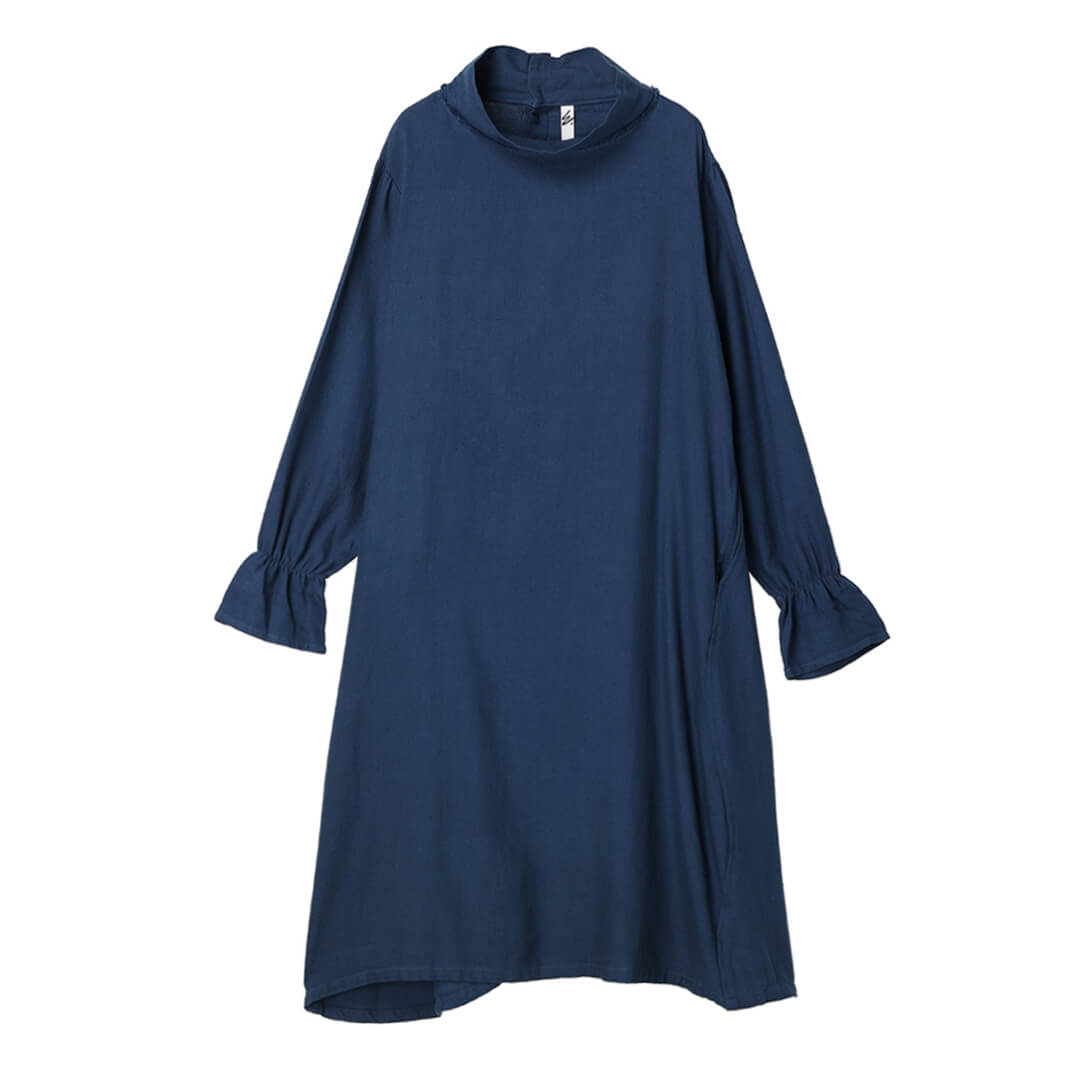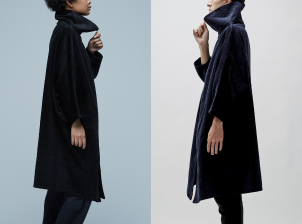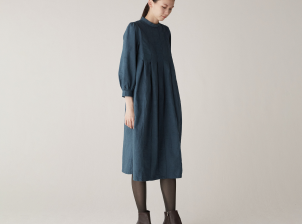
デザイナーの山口絵理子です。 作っている時のインスピレーションの原点やこだわりを ご紹介いたします。
56dt twill Khadiという生地を使ったワンピースです。この生地に圧倒的な魅力は、手紡ぎ手織りからくる、柔らかさと軽さです。
「それを最大限に活かしたワンピースを作りたい」と思い着手しました。
羽織ではなく、ワンピースなので、最初、生地を広げて頭が入るだけの丸い穴をくり抜いて、私は自分の頭をそこに入れて、文字通り、纏いながらチョキチョキハサミを入れて作りあげていきました。
その滑稽な作り方は絶対にお見せできるものではないのですが笑、鏡を見ながら、生地を纏いながら作るのです。
この手紡ぎの生地を纏っていると、切るのがもったいないなって度々思うんです。
「くるまっていたい・・・」という感覚になり、最低限のハサミで形を作りたいと。素材とこうして向き合うまでは、紙に絵を描いて、型紙を作ってもらい、という王道の開発のプロセスをやってきた過去もあるのですが、素材との対話の中で作り上げる今のスタイルに辿り着き、「ああ、この素材が喜ぶようなスタイルを作るからね」となんだか素材と親密な関係になれた気がします。このワンピースを作った時、「56dt twillのふんわり軽く、包容感溢れるこの素材に包まれた感覚をそのまま再現したい」って思いました。生地へのリスペクトを形に。それがこのアイテムのコンセプトです。
柔らかいハイネック
ハイネックはERIKO YAMAGUCHIのモデルに多く出現します。
私の考えとして、胸元が大きく開いたスタイルはとても西洋的だと感じていて、日本は着物からも表れているように、首のラインにピッタリと沿ったものや、首元は開けすぎないことが、謙虚さと恥じらいと大人らしさがあり、私は好きなんです。
そんな考えの元、ハイネックを多用していますが、ハイネックの作り方も一歩間違えると、とても顔が大きく見えたり窮屈さを与えてしまったりします。
私は作りながら、首との間にゆとりがあったり、フェイスラインと重なるほどの高さが最も日本人の顔や身長に似合うのではないかと思ってきました。
そして、ハイネックの高さやゆとりについてのベストなバランスは、生地が決めます。
生地に張りがあり、ピンと立ってくれる場合は、わりと低く、ちょこっと首の低い位置にある方がバランスが良く、56dtのように生地が柔らかい場合は、首全体を覆うくらいのボリュームがあった方が顔全体を小さく見せて、バランスが収まると思っています。
そうしたスタイリングの考えのもと、このワンピースは、柔らかいハイネックとボリューミーなボデイの組み合わせにしたのです。

着るものによって、顔のサイズが変わったようにも見えてしまう、襟の力って本当にすごい・・・!毎度考えさせられる私です。
華奢感を演出するくしゅくしゅ袖
手首のちょっと上に、ギャザーによって絞りとなっているポイントがあります。

これは私の中で、女性らしさを少し味付けしたいなっていう気持ちと、このワンピースの袖は通常のサイズよりも長く設計されているので、機能的に腕を捲って作業をしたい時のニーズを満たすためにつけました。
このギャザーはゴムによって作られているのですが、その加減にも配慮しました。キツくてゴム跡が着くなんて嫌だし、かといって、腕を捲ったのに落ちてきてもイライラします笑。なので、程よいゴムの太さや加減を選びました。
このギャザーの部分があるかないかで、だいぶ印象が変わると思いませんか?
これがあることで、逆にボリューミーな袖であることの印象がとても強くなり、手首でキュッとなることで華奢な感じも演出できている気がします。
女性の場合は、ボディ全体のオーバーサイズ感も相まって、華奢感が出ちゃうフリーサイズなワンピースです。
非対称な胴体
どうしても言いたいポイントがあります。ボディの前後左右は、実は非対称な形をしています。
本来生産効率などを考えると同じシルエットにした方が良いのですが、右には三角形のマチが、左には波打ったような曲線のマチがついていて、ボディーの形もそれに合わせて左右少しずつ変えています。

言葉だと伝えづらいのですが、着用した時に、ボディが単純なシルエットではなく、ややリズムや躍動感があることが理解していただければ、それはパターンによるものだということです!
縫製や布でわざと、こんな感じの違和感を醸成させることが、服を作っていてとても面白い部分です。教科書的に言えば、そんなものは必要なく、そして非効率もあること。それでも何か料理でいう隠し味のようなものだと私は思っていて、人が一瞬で感じる誤差のような部分に、魂を入れたいというか、そんなふうに一点一点アイテムというか、作品を作るようにしています。
Matou Asymmetry OP 56dt twill Khadi
マトウ アシンメトリー ワンピース 56dt ツイル カディ
¥41,800(税込)











RECENT VIEW
SNS & MAIL MAGAZINE
- 選択結果を選ぶと、ページが全面的に更新されます。
- 新しいウィンドウで開きます。









































